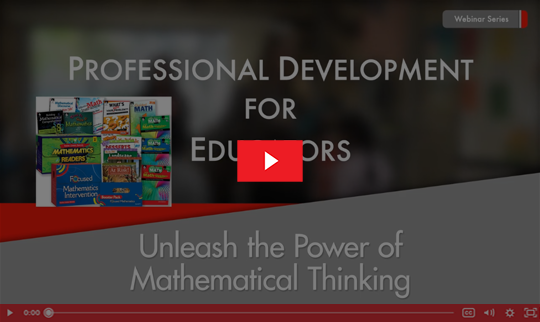Purposeful Prompting: Making Math Practices Explicit
Enrich math learning experiences in the classroom when you enable students to understand the content and to see themselves as mathematicians. In this article, learn how you can prompt your students to use math practices while solving problems.
Students as Mathematicians
Can students think, negotiate, and strategize as mathematicians do? The answer is absolutely yes, and there’s a clear path to get them to do this.
State standards for mathematics outline grade-level content standards (conceptual categories for high school) that define what students should know and be able to do in the discipline of mathematics. These content standards are paralleled by Standards for Mathematical Practice (K–12) that define the characteristics and dispositions of mathematicians. In the standards-based mathematics classroom, students must understand the content and see themselves as mathematicians.

Mathematician’s Role
The role of a mathematician is not just to derive answers but also to strategically negotiate tasks and then use the answer to validate that process. The Math Practices outline these tools of negotiation. Mathematicians know when and why to use these tools based on a given context. This is a skill that can be taught through purposeful prompting. The math practices include:
- meaning making
- perseverance
- abstract reasoning
- argument construction
- critic
- modeling
- tool selection
- precision
- structure
- uncovering patterns
Prompting Mathematical Actions
Prompts serve as scaffolds or cues that signal an action based on a situation. For example, stop signs tell us how to act when approaching street intersections. The referee’s whistle signals a beginning or end to play. This concept of prompting can be used in the math classroom to illicit mathematical behavior. Teachers can assign symbols or illustrations to each mathematical practice. An image web search for standards of mathematical practices yields many graphic options.
Here is an example.
There were two groups of students from Galiano Elementary School walking to the library when it began to rain. The seven students in Mr. Corallo’s group shared the three large umbrellas they had with Ms. Well’s group of 11 students. If the same number of students were under each umbrella, how many students were under each umbrella?
Teachers may ask students, “What factors are known and unknown in the problem?” This targets mathematical practice #1 (MP1), specifically making meaning of problems. Students may answer the question but may be unaware of the mathematical characteristic being developed. As the teacher asks the students the question, he/she can display the selected MP1 prompt and engage in the conversation of what it means to make meaning of a problem and the importance of the skill.
The visual posting of prompts, and the pending discussion of how and why they were used, make the tacit curriculum explicit. In turn, students begin to select the mathematical practices in a self-regulatory manner while solving problems. The prompts eventually disappear as students understand their role as mathematicians—negotiators of content.
Author Bio:
View All AuthorsJared DuPree, Ph.D., Principal
Dr. Jared DuPree is a high school magnet principal in the Los Angeles Unified School District. He is a former LAUSD regional Mathematics Coordinator. He holds a Doctorate in Education from the University of Southern California. He also holds a Bachelors of Science in Mathematics and a Masters of Arts in Educational Administration. As a current secondary math educator, he strives to present the objective nature of mathematics in a subjective manner providing access for students at all levels.
Join the TCM Blog Community
Subscribe by sharing your email address and we will share new posts, helpful resources and special offers on the issues and topics that matter to you and the children and teens you support.

